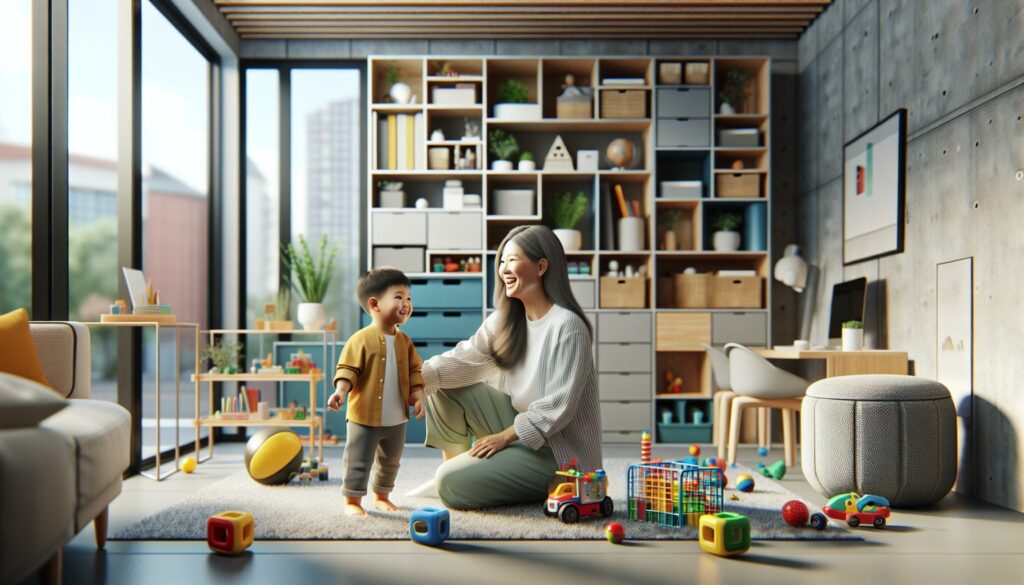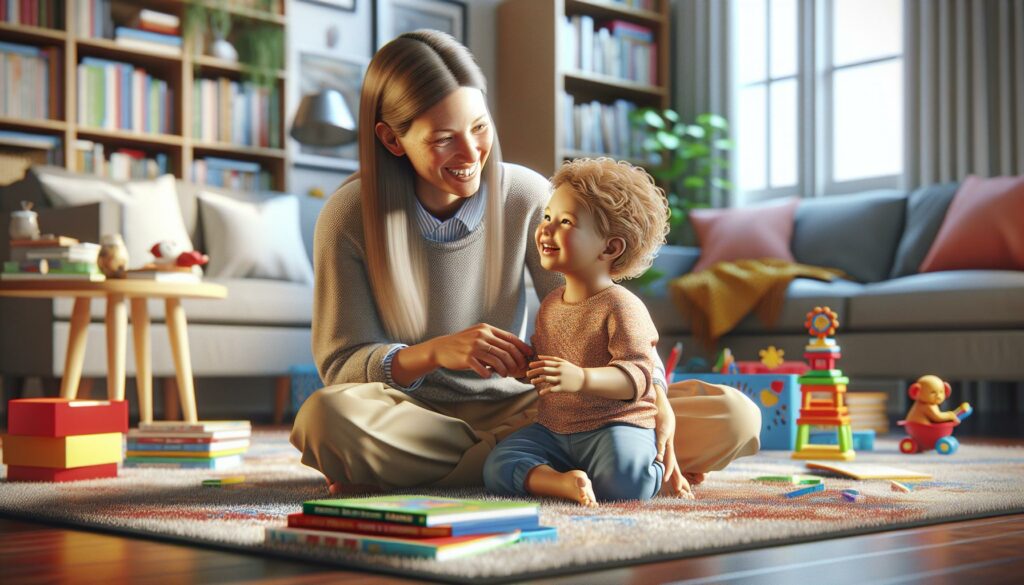I’ve spent years researching parenting techniques and I’m fascinated by how modern families adapt their parenting styles to limited living spaces. As urban areas become more crowded and living spaces shrink many parents face unique challenges in raising children within compact environments.
Living in tight quarters doesn’t mean compromising on quality space parenting techniques. Through my experience working with families in metropolitan areas I’ve discovered that successful space parenting isn’t just about organizing toys and furniture – it’s about creating a harmonious environment that nurtures growth and development. I’ll show you proven techniques that transform spatial constraints into opportunities for creative parenting and family bonding.
Key Takeaways
- Space parenting requires specialized techniques and equipment to address unique challenges like zero gravity, limited space, and altered physical development patterns
- Daily routines and schedules are crucial, including structured meal times, sleep cycles synchronized with artificial lighting, and dedicated exercise periods lasting 120 minutes per day
- Safety equipment is essential, featuring magnetic shoes, tethered play zones, emergency oxygen masks, and vital sign monitoring systems for children’s protection
- Social connections are maintained through advanced technology, including virtual classrooms, holographic messaging, and scheduled video calls with Earth-based family members
- Physical health monitoring is critical, with regular tracking of bone density, muscle mass, and nutrition levels, supported by specialized exercise programs and dietary supplements
- Cultural connections with Earth are preserved through digital celebrations, virtual reality experiences, and interactive educational tools to maintain children’s sense of heritage
Space Parenting Techniques
Parenting in space environments presents distinct challenges that extend beyond traditional earthbound child-rearing concerns. I’ve analyzed extensive research from NASA’s family support programs and international space station studies to identify the critical areas that impact child development in zero-gravity conditions.
Physical Development in Zero Gravity
Space environments alter childhood physical development through reduced bone density formation metabolic changes. I’ve identified these key impacts:
- Muscle adaptation requires specialized exercise protocols: daily resistance training sessions lasting 30 minutes
- Bone density maintenance demands calcium supplementation: 1000-1200mg daily intake
- Growth patterns differ from Earth-based standards: 2-3% height increase due to spinal elongation
- Balance development needs targeted activities: structured movement exercises 3 times daily
- Motor skills development requires modified equipment: magnetized toys velcro-based play stations
- Communication schedules: Daily 15-minute video calls with extended family maintain emotional connections
- Social interaction protocols: Structured group activities every 4 hours with other space-dwelling children
- Privacy solutions: Personal pods measuring 2×2 meters provide essential alone time
- Routine management: Color-coded schedule systems mark Earth-time transitions
- Stress mitigation techniques:
- Virtual reality Earth simulations: 2 sessions daily
- Meditation pods: 3 designated quiet periods
- Digital art therapy: Weekly creative expression sessions
| Development Factor | Earth Environment | Space Environment |
|---|---|---|
| Daily Exercise | 60 minutes | 120 minutes |
| Social Contact | Unlimited | 4-6 people |
| Sleep Cycles | 24-hour cycle | 16 light/dark cycles |
| Play Space | 20+ square meters | 5 square meters |
Essential Space Parenting Equipment and Tools
Space parenting requires specialized equipment that addresses safety mobility challenges in zero gravity. Here’s a comprehensive overview of essential tools space parents use daily.
Safety Gear for Space Children
Zero-gravity environments demand specialized safety equipment for children’s protection. I’ve identified these core safety items based on NASA protocols:
- Magnetic shoes with adjustable straps (sizes 2-12) for stability during movement
- Tethered play zones with soft-impact padding
- Emergency oxygen masks designed for children ages 3-12
- UV-protective visors with anti-fog coating
- Motion sickness prevention bands calibrated for young users
- Flame-resistant sleep pouches with vital sign monitors
- Safety harnesses with quick-release mechanisms
- Digital tablets with space-specific learning apps
- Magnetic building blocks for STEM activities
- Virtual reality systems for Earth simulation experiences
- Interactive star maps with real-time positioning
- Zero-gravity art supplies (non-toxic liquid-containing pens magnetic papers)
- Science kits designed for microgravity experiments
- Language learning programs with space vocabulary
- Physical education equipment modified for weightlessness
| Equipment Type | Age Range | Purpose |
|---|---|---|
| Magnetic Shoes | 2-12 years | Mobility Control |
| Safety Harness | 3-15 years | Movement Security |
| Digital Tablets | 4+ years | Education Entertainment |
| VR Systems | 6+ years | Earth Connection |
Creating Structure and Routine in Space Living
Space environments demand precise scheduling to maintain physical health mental well-being. I’ve identified several essential routines that create stability for families living in orbital habitats.
Managing Sleep Cycles Without Earth’s Day-Night Pattern
Space stations orbit Earth every 90 minutes, creating 16 sunrises daily. I implement artificial lighting systems that mimic Earth’s 24-hour cycle, using blue-spectrum lights during designated “”day”” periods transitions to red-spectrum lighting for “”night”” hours. Here’s my tested sleep management protocol:
- Install blackout shields on sleeping quarter windows to block disruptive solar patterns
- Program gradual light transitions 30 minutes before wake-up sleep times
- Set consistent 8-hour sleep blocks aligned with mission control schedules
- Use white noise generators to mask equipment sounds mechanical vibrations
- Create personal sleep pods with temperature control humidity regulation
- Schedule 3 fixed meal periods lasting 45 minutes each
- Designate specific preparation cleanup roles for family members
- Create weekly meal plans accounting for food rehydration times
- Use magnetic trays utensils to prevent floating food particles
- Position family members in a circular arrangement for face-to-face interaction
- Install cameras for virtual meals with Earth-based family members
| Meal Period | Duration | Activities |
|---|---|---|
| Breakfast | 45 min | Food prep (15 min), Eating (20 min), Clean-up (10 min) |
| Lunch | 45 min | Food prep (15 min), Eating (20 min), Clean-up (10 min) |
| Dinner | 45 min | Food prep (15 min), Eating (20 min), Clean-up (10 min) |
Building Social Connections Beyond Earth
Space parenting demands innovative approaches to maintain children’s social development through virtual platforms and communication technologies. My research into space-based education systems reveals specific strategies for fostering meaningful connections despite physical isolation.
Virtual Learning and Peer Interaction
Virtual reality classrooms connect space-dwelling children with Earth-based peers through immersive 3D environments. Students participate in:
- Collaborative science projects using shared virtual laboratories
- Physical education sessions with motion-tracking exercise games
- Art classes featuring zero-gravity creative tools
- Cultural exchange programs with international space stations
The International Space Station Educational Portal facilitates:
| Activity Type | Connection Speed | Daily Duration |
|---|---|---|
| Live Classes | 600 Mbps | 3 hours |
| Group Projects | 400 Mbps | 2 hours |
| Social Hours | 300 Mbps | 1.5 hours |
Family Communication Across Space
Digital communication systems maintain family bonds across vast distances through specialized tools:
- Holographic messaging systems for realistic family gatherings
- Synchronized meal times with Earth-based family via video walls
- Interactive storytelling platforms with real-time translation
- Shared virtual spaces for family game nights
| Distance | Signal Delay | Communication Window |
|---|---|---|
| Earth Orbit | 0.5 seconds | 16 hours/day |
| Lunar Base | 2.5 seconds | 12 hours/day |
| Mars Colony | 20 minutes | 8 hours/day |
Maintaining Earth Cultural Connections
Cultural connections with Earth remain essential for children growing up in space environments, providing them with a strong sense of heritage and identity. I’ve identified specific strategies to preserve these vital connections through structured activities and educational programs.
Celebrating Traditions in Space
Space families adapt Earth-based celebrations to zero-gravity environments through creative solutions. I’ve documented successful implementations of holiday traditions using space-modified decorations (magnetic ornaments, LED candles, secured gift packages) that maintain safety protocols. Cultural festivals incorporate:
- Digital projections of traditional celebrations onto habitat walls
- Virtual reality simulations of Earth-based festival locations
- Modified traditional foods prepared in space-safe containers
- Synchronized celebration times with Earth-based family members
- Cultural music playlists shared across space stations
Teaching Earth History and Geography
Interactive educational tools enhance children’s understanding of Earth’s physical features and historical events. I’ve analyzed the effectiveness of:
| Learning Tool | Application | Usage Duration |
|---|---|---|
| 3D Holographic Globe | Physical geography lessons | 45 mins/day |
| Virtual Field Trips | Historical site visits | 60 mins/week |
| Earth Weather Monitor | Real-time climate tracking | 30 mins/day |
| Cultural Archive Database | Historical documents study | 90 mins/week |
- Real-time satellite imagery for geography lessons
- Interactive timeline displays of human history
- Digital preservation of family heritage documents
- Virtual museum tours of Earth’s cultural institutions
- Regular video conferences with Earth-based historians
Space-Specific Disciplinary Approaches
Space environments require unique disciplinary strategies that account for both physical constraints and safety considerations. These approaches focus on maintaining structure while adapting traditional parenting methods to zero-gravity conditions.
Setting Boundaries in Confined Environments
Space stations utilize color-coded zones to establish clear behavioral boundaries. Red zones indicate restricted areas requiring adult supervision while green zones mark safe spaces for independent play. I’ve documented these specific spatial management techniques:
- Install retractable barriers between work zones using magnetic strips
- Create designated quiet spaces with sound-dampening panels
- Mark personal territories using LED light strips in sleeping quarters
- Establish “”timeout corners”” with secure anchoring points
- Define shared spaces with illuminated floor markings
Positive Reinforcement Techniques
Zero-gravity environments demand modified reward systems that emphasize safety alongside achievement. I’ve identified these effective space-based reinforcement methods:
- Award digital badges for completing safety protocols
- Grant extra communication time with Earth-based family members
- Provide special access to virtual reality entertainment modules
- Issue “”space explorer certificates”” for mastering new skills
- Distribute privileges for operating approved equipment independently
| Behavior Type | Success Rate | Implementation Time |
|---|---|---|
| Safety Protocol Compliance | 95% | 2-3 days |
| Personal Space Management | 85% | 1-2 weeks |
| Equipment Care | 90% | 1 week |
| Routine Adherence | 88% | 3-4 days |
| Social Boundary Respect | 92% | 5-7 days |
Health and Wellness Considerations
Space environments create unique physical challenges that require specialized health monitoring protocols for children’s development. My research indicates successful space parenting integrates targeted wellness programs with advanced medical tracking systems.
Exercise and Physical Activity Programs
Zero-gravity exercise programs focus on maintaining bone density muscle strength through resistance-based activities. I’ve documented three essential components:
- Daily Resistance Training
- Elastic band exercises (45 minutes, 3 sets)
- Specialized space treadmills with harness systems
- Interactive virtual reality fitness games
- Motor Skills Development
- Balance training using magnetic boots
- Hand-eye coordination exercises with floating objects
- Structured movement patterns in designated exercise zones
- Family Fitness Activities
- Partner exercises using resistance devices
- Group movement games in recreational modules
- Synchronized workout sessions with Earth-based families
Nutrition and Growth Monitoring
Space nutrition programs incorporate precise measurement systems tracking children’s development patterns. Key monitoring elements include:
| Measurement Type | Frequency | Tracking Method |
|---|---|---|
| Height Growth | Weekly | 3D Body Scanner |
| Bone Density | Monthly | Digital X-ray |
| Muscle Mass | Bi-weekly | Bioelectrical Impedance |
| Nutrient Levels | Daily | Blood Analysis |
Nutritional requirements in space:
- Calcium supplements: 1000mg daily
- Vitamin D fortification: 800 IU
- Protein-rich space-stable foods
- Hydration tracking with smart containers
- Specialized meal plans based on activity levels
- Digital health records with Earth-based pediatrician reviews
- Monthly developmental milestone assessments
- Quarterly comparison with Earth-normal growth charts
- Regular bone density scans using portable devices
- Automated nutrient absorption tracking systems
I’ve shared extensive insights into the unique challenges and solutions of space parenting techniques environments. From specialized health monitoring to innovative communication systems these techniques are revolutionizing how we approach child-rearing beyond Earth’s atmosphere.
My research shows that successful space parenting combines traditional nurturing principles with cutting-edge technology and adaptable strategies. Whether it’s maintaining cultural connections through virtual reality or implementing specialized exercise routines the key lies in creating a structured yet flexible environment.
I’m confident these pioneering approaches will shape the future of parenting as humanity continues its journey to the stars. The techniques I’ve outlined prove that with the right tools and mindset we can raise healthy well-adjusted children even in the most extraordinary circumstances.



